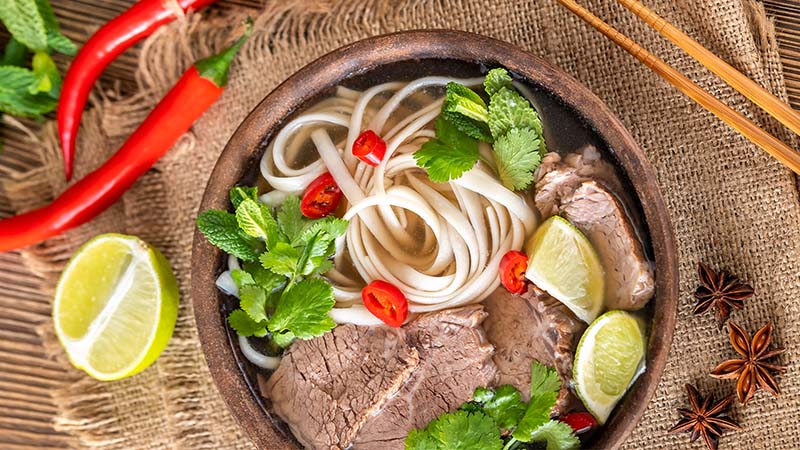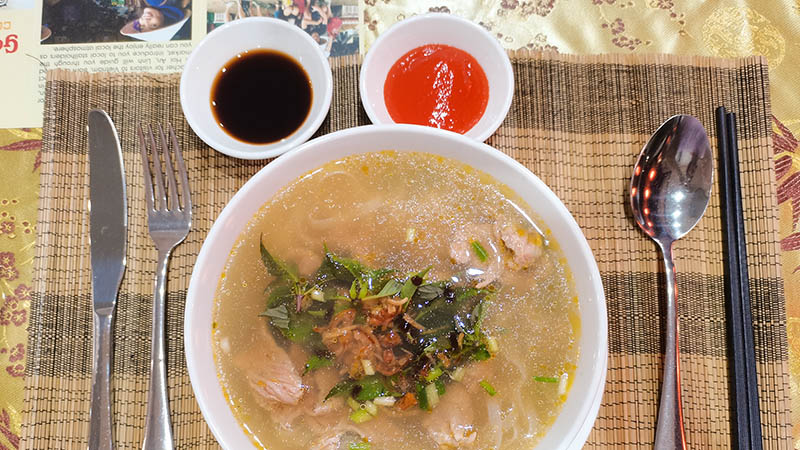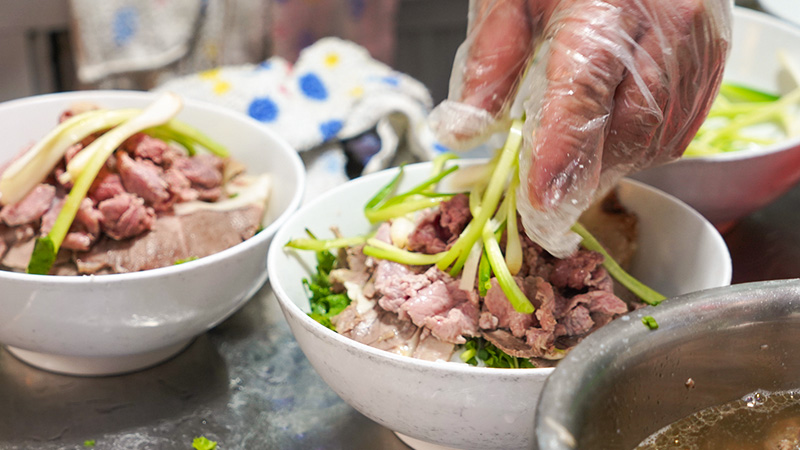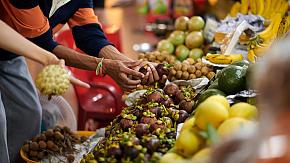Vietnamese Pho: Broth, Rice Noodles, and Meat That Perfectly Match
Who can refuse a bowl of good-looking and delicious pho during a tour of Vietnam? Even if you try it for the first time, you'll likely fall for it. Trying a bowl of pho is a must during your Vietnam journey, and one bowl is often far from enough.
What Is Pho
Pho (Phở in Vietnamese, pronounced [fə:vl]), a traditional Vietnamese noodle soup, consists of broth, rice noodles, herbs, and meat (beef or chicken). This flavorful and aromatic Vietnamese dish is popular throughout Vietnam, from street food stalls to high-end restaurants. Influenced by Cantonese and French cultures, Vietnamese pho is light and fresh, with rich layers of flavor and a lingering aftertaste (you'll understand why it tastes so good after reading the recipe below).
Types of Pho and Garnishes
The main types of pho are beef pho (phở bò), chicken pho (phở gà), and seafood pho (phở hải sản). Additionally, vegan pho (phở chay) is meat-free and made from vegetables and sometimes mushrooms, with tofu as a topping, making it very suitable for vegetarians.
Typically, pho is served with fish sauce and vegetables such as bean sprouts, fresh sliced chili, key limes, and a variety of fresh herbs (green onions, ginger, and coriander). Customize your bowl with these garnishes to create your perfect Vietnamese noodle soup. Fried dough sticks (bánh quẩy) are also a must for dipping in the broth.
 Vietnamese Pho
Vietnamese Pho
Where to Eat Pho in Vietnam
While many well-decorated tourist restaurants serve pho, it is still recommended to enjoy it at a small local vendor frequented by locals. Travel with Odynovo to experience a mix of traditional and regional pho across Vietnam. Your tour guide will show you the best local restaurants for authentic Vietnamese pho. Experiencing the local hustle and bustle is an unforgettable part of travel.
Pho in Hanoi
Pho originated in Hanoi. In the northern part of Vietnam, pho is typically lighter, with simpler garnishes and a wider variety of meats. If you can only try one bowl of pho, make sure it's in Hanoi, where you can experience the most traditional versions of this Vietnamese dish.
Pho in Hue and Hoi An
Pho in Hue or Hoi An is distinctive and often includes both beef and pork. The broth might be spicier and richer, with more herbs and additional flavorings.
Pho in Saigon (Ho Chi Minh City)
In the southern part of Vietnam, particularly Saigon, the pho broth is usually sweeter and contains more vegetables.
How to Eat Pho Like a Local
When faced with a steaming bowl of noodle soup, especially if it's your first time savoring this national dish of Vietnam, you might face a challenge - how to use chopsticks. Don't worry; you'll quickly get the hang of it.
There is no specific etiquette you must follow when eating in a pho shop, but if you want to eat like a local, here are some steps for your reference:
1. Start with the Broth: The broth is the soul of pho. Begin with a spoonful of broth. It's hot! Take a sip to enjoy the clear, aromatic soup and appreciate its rich flavor. Locals judge the quality of pho by its broth, which should be light yet full of flavor.
2. Add Garnishes: Besides the toppings, you can add any garnishes offered with your pho. Choose according to your taste. Typically, local Vietnamese will add bean sprouts, coriander, and sliced chili (not too spicy), then squeeze in lime juice (they usually provide 2-3 halved limes per bowl). For your first bowl, it's best not to add too many garnishes as they might overpower the primary taste.
3. Mix in Sauces: Fish sauce is a Vietnamese specialty you can't miss. Add a splash of fish sauce or hoisin sauce to enhance the flavor of the noodles. But don't overdo it; just a little is enough for a finishing touch.
4. Stir and Taste: Mix the ingredients in your bowl with the soup and rice noodles. Use one hand to pick up noodles, meat, and other ingredients with chopsticks, and the other hand to spoon the broth. Take a bite of noodles and a sip of soup. Adjust the seasonings if needed.
5. Dip the Fried Dough Sticks into the Broth: An authentic pho experience includes dipping fried dough sticks into the broth.
6. Add One More Bowl of Pho if You Are Feeling Not Enough. Yummy! ^-^
 Vietnamese Pho
Vietnamese Pho
Pho Beyond Vietnam
In many shops or supermarkets in Vietnam, you can find Vietnamese Pho Instant Noodle Bowls. If you love this food, you can buy some instant pho to take home. The price is very reasonable (usually no more than $2), and it generally lasts about 6 months.
Vietnamese Pho Ingredients (Beef Pho Example)
Want to make homemade pho? If you have some cooking skills, you can easily prepare it with the following ingredients and recipe.
For the Broth:
• 3 lbs beef bones (a mix of marrow and knuckle bones is best)
• 1 yellow onion
• 1 thumb-sized piece of ginger
• 1 cinnamon stick
• 3-star anise
• 5 whole cloves
• 3 cardamom pods
• 1 tsp fennel seeds
• 1 tsp coriander seeds
• 2 tbsp rock sugar (preferred) or regular sugar (substitute)
• 1 tbsp fish sauce
For Serving:
• 1 lb beef brisket or sirloin
• 1 package dried rice noodles (bánh phở)
• Fresh herbs: cilantro, basil, mint
• Bean sprouts
• Halved lime (for squeezing) or lime wedges (for adding to the broth)
• Sliced chili peppers
• Sliced onions (optional)
• Hoisin sauce
• Sriracha or other chili sauce (optional)
 Vietnamese Pho
Vietnamese Pho
Vietnamese Pho Recipe
Prepare the Broth:
1. Put the beef bones into cold water in a large pot. Bring to a boil, then take the bones out and rinse them under cold water to remove impurities. For a richer broth, you can make a combination of beef and chicken bones.
2. Roast the whole onion and ginger over a low flame directly or roast the halved onion and sliced ginger in a preheated oven at 400°F (200°C) for about 15-20 minutes until charred. After roasting, cut the charred parts and smash them. This is a very important step to make the broth with a special aroma.
3. Place the cleaned bones back in the pot, cover with fresh water, and bring to a boil again. Then reduce to a gentle simmer. Add the smashed onion and ginger, cinnamon stick, star anise, cloves, cardamom pods, fennel seeds, and coriander seeds.
4. Simmer the broth for at least 3-4 hours over gentle heat. Skim off any foam or impurities. Add sugar, salt, and fish sauce before turning off the heat.
5. Remove the bones and spices, then strain the broth through cheesecloth or a fine-mesh sieve into a large container. Congratulations! You've made the broth - the hardest part of making delicious Vietnamese pho.
Prepare the Noodles and Meat:
1. Clean the fresh herbs and bean sprouts, and prepare all the ingredients.
2. Boil a pot of water and put the dry rice noodles into it. Stir gently and cook until soft. Some noodles may only need to soak in the hot water, so follow the package instructions. Drain and place them in your bowl.
3. Slice the beef brisket or sirloin as thinly as possible. Slightly freeze the beef before slicing to make it easier. Place the raw beef on top of the rice noodles.
4. Reheat the broth to a boil. Ladle the hot broth over the noodles and beef to cook the beef slices and make them tender.
5. Serve the pho with fresh herbs, bean sprouts, sliced chili peppers, and lime wedges (or squeeze the juice into the broth), with optional hoisin or sriracha sauce on the side. Customize the garnishes to your taste for added flavor and freshness.
Now, enjoy your homemade Vietnamese pho! Don't forget to invite family and friends to join you.
Of course, when you crave the best-tasting pho, the best way is to buy a plane ticket and fly to Vietnam to savor it on-site. That's where Odynovo can help.
Related Posts You May Like
What Our Clients Say
Explore the latest verified reviews of Odynovo's travel services on Tripadvisor, Google, Trustpilot, Product Review and more trusted platforms.













